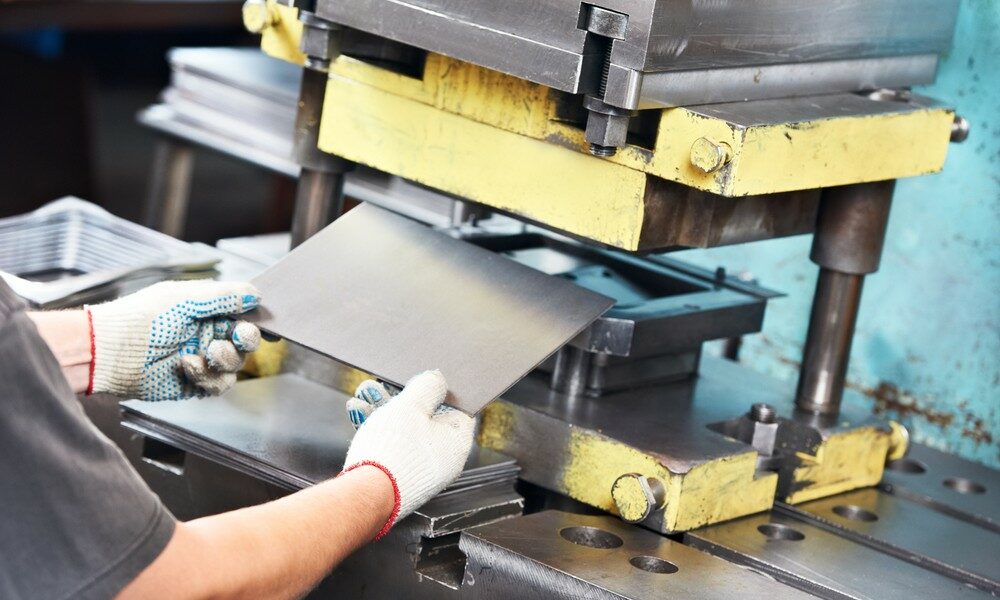Specialist Tips for Picking the Right Metal Stamping Providers for Your Demands
Specialist Tips for Picking the Right Metal Stamping Providers for Your Demands
Blog Article
Advanced Techniques in Steel Stamping for Accuracy Manufacturing
As markets continuously demand better resistances and elaborate styles in their steel elements, the pursuit for innovative techniques in metal stamping has increased. From the application of innovative multi-stage stamping procedures to the assimilation of advanced automation innovations, the landscape of metal marking is undergoing an extensive improvement.
Advanced Multi-Stage Stamping Processes
Discussing the details of sophisticated multi-stage stamping procedures discloses the advanced methods employed in modern-day production practices. Metal Stamping. Multi-stage marking is a complex process that entails multiple steps to transform a level sheet of steel right into a final stamped product. Using modern dies, where various operations are done at each phase of the stamping process, permits high accuracy and performance in the manufacturing of complex metal parts
Throughout the first phases of multi-stage marking, the flat metal sheet is fed right into the stamping press, where a collection of passes away are utilized to reduce and form the product. Succeeding phases involve additional forming, flexing, and punching operations to additional refine the part. Each stage is meticulously made to build on the previous one, resulting in the development of intricate geometries with limited tolerances.
Advanced multi-stage marking processes require a high degree of knowledge and precision to make sure the top quality and consistency of the stamped components. By making use of innovative machinery and tooling, producers can generate a large range of metal elements with efficiency and accuracy.
Accuracy Tooling Innovations
Precision tooling developments have actually reinvented the metal stamping market, boosting effectiveness and high quality in manufacturing processes. CNC systems allow for intricate styles to be translated directly into tooling, ensuring precision and repeatability in the marking process.
Furthermore, the combination of sensing units and real-time monitoring capacities in precision tooling has allowed producers to spot and resolve problems without delay, minimizing downtime and minimizing scrap prices. By integrating wise technology right into tooling, operators can enhance specifications such as pressure, speed, and alignment during the stamping operation, resulting in boosted product high quality and increased efficiency.

Automation in Metal Stamping
The evolution of precision tooling innovations in the steel stamping industry has paved the means for significant improvements in automation, transforming the manufacturing landscape towards boosted efficiency and productivity. Metal Stamping. Automation in metal marking includes the usage of advanced machinery and robotics to perform numerous jobs generally brought out by human drivers. This shift towards automation supplies countless advantages, including enhanced accuracy, quicker production cycles, and decreased labor expenses
One trick element of automation in metal marking is the implementation of computer system numerical control (CNC) systems, which allow this content accurate control over the marking process. CNC innovation enables for the creation of complicated and elaborate steel get rid of regular top quality. Additionally, automated systems can be programmed to run constantly, leading to greater output prices and much shorter lead times.
Additionally, automation improves workplace safety and security by minimizing manual handling of hefty products and decreasing the threat of mishaps (Metal Stamping). As producing markets remain to embrace automation, the future of metal marking holds fantastic pledge for even better performance and innovation
High-Speed Stamping Strategies

One of the primary advantages of high-speed marking methods is the ability to produce a big volume of parts in a shorter amount of time compared to typical stamping techniques. This boosted efficiency not just enables makers to satisfy limited manufacturing deadlines but additionally makes it possible for price financial savings via economic climates of scale. Furthermore, high-speed stamping can help in reducing material waste by optimizing the material usage during the marking process.
Additionally, high-speed stamping techniques frequently incorporate cutting-edge attributes such as fast die modification systems and real-time monitoring capabilities, better enhancing the overall efficiency and adaptability of the steel stamping process. As modern technology remains to advance, high-speed marking is expected to play an important role in driving the future of precision manufacturing.
Quality Assurance in Stamping Procedures
Efficient quality control actions are crucial for making sure the dependability and uniformity of steel stamping procedures. Quality assurance in stamping procedures involves a collection of methodical processes aimed at detecting and protecting against problems in the manufactured elements. One essential facet of quality assurance in metal marking is the use of sophisticated inspection strategies such as optical evaluation systems and coordinate gauging makers (CMMs) to verify the dimensions and resistances of stamped parts.
Furthermore, quality assurance procedures in marking operations usually consist of the Continued implementation of statistical procedure control (copyright) methods to keep an eye on the manufacturing process in real-time and make sure that it remains within acceptable restrictions. By analyzing data and determining trends, suppliers can proactively deal with any type of inconsistencies from the preferred quality standards.
Furthermore, top quality control in steel stamping view publisher site operations likewise includes comprehensive material screening to make certain that the raw products used satisfy the required requirements for the stamping procedure. This may consist of conducting material hardness examinations, tensile stamina tests, and dimensional assessments to assure the top quality and integrity of the stamped elements. Generally, carrying out durable top quality control actions is essential for achieving top notch stamped components consistently.
Conclusion
To conclude, advanced techniques in steel marking play a crucial role in precision manufacturing procedures. Via multi-stage marking processes, ingenious tooling services, automation, high-speed methods, and rigorous quality control measures, suppliers can attain greater levels of accuracy and performance in their procedures. These improvements in metal stamping modern technology have actually allowed business to produce intricate get rid of tight tolerances, inevitably bring about boosted product quality and consumer satisfaction in the production market.
Report this page